As we have been working on Project TinyMiniMicro, we have had many readers from companies that use Lenovo desktops and workstations highlight the Lenovo ThinkStation P360 Ultra. Now, we have one for review. This 3.9L (plus power adapter) workstation offers impressive performance and expandability in a small form factor.
Lenovo ThinkStation P360 Ultra Overview
As we have been doing with many of these units, we have a video to go alongside the review:
Lenovo sent us this system to review, and it is a higher-spec configuration with an Intel Core i9-12900 65W CPU and a NVIDIA RTX A5000 16GB (mobile) GPU. Both of those options significantly increase the price.
The “value” options were the 32GB of RAM configuration as well as the 1TB NVMe SSD. We decided to augment a bit thanks to our YouTube Members that help support things like upgrading memory in these systems.
All told, depending on channel and discount, this system usually retails for $4,200-4,800. There are many STH readers that are going to look at that and immediately think, “I can build a SFF PC for less.” In this case, that is completely true. On the other hand, this is a fairly unique platform and it is also designed to get certifications from major ISVs for professional applications.
Lenovo ThinkStation P360 Ultra External Hardware Overview
On the front of the system, we have a feature set that goes well beyond the TinyMiniMicro 1L PCs. We still get a power button and a combo headset jack. There is a USB 3.2 Gen2 port as well. Perhaps the exciting part is that we get two Thunderbolt ports on this workstation platform in the front of the chassis.
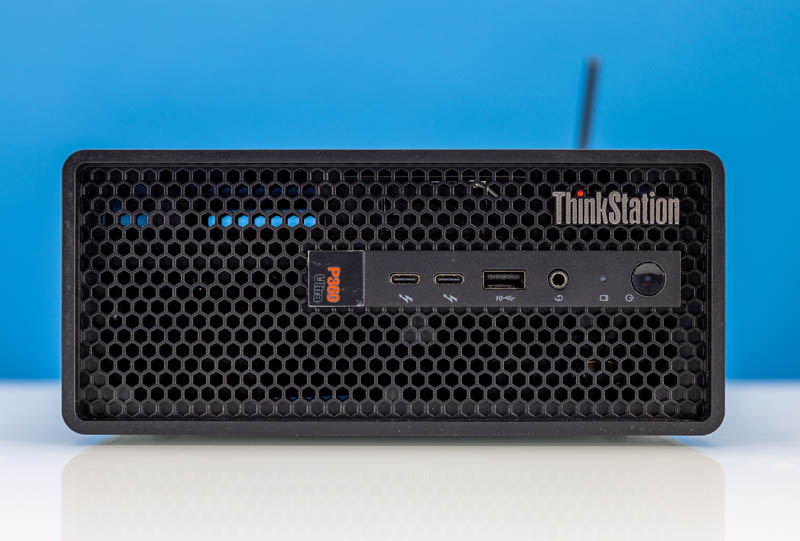
Using the system, it would have also been nice to have a second USB Type-A port just to make it easier to plug in a keyboard and mouse. The rest of the system, though, is devoted to ThinkStation branding and airflow. The front mesh on the system is designed to push air though the chassis.
The side is less remarkable.
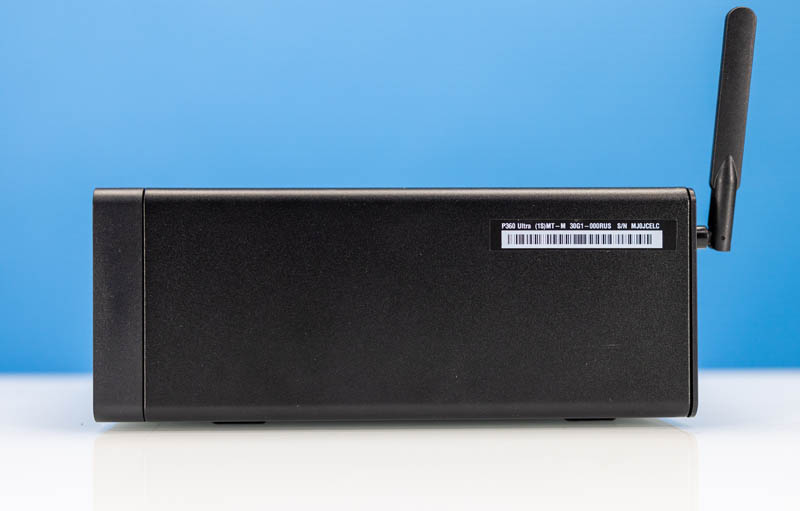
The other side has rubber feet and labeling.
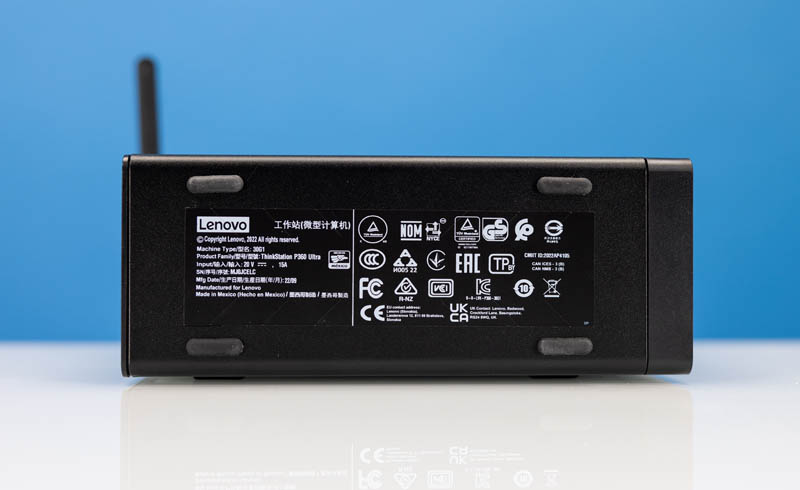
The rear of the system is where the magic happens. Here we have a lot of ports, more than a TinyMiniMicro PC by a large margin. First, there are two network ports. One is a 2.5GbE port the other is 1GbE. That is one where it would have been nice to have two 2.5GbE ports instead. The USB connectivity is four USB 3.2 Gen2 Type-A ports.
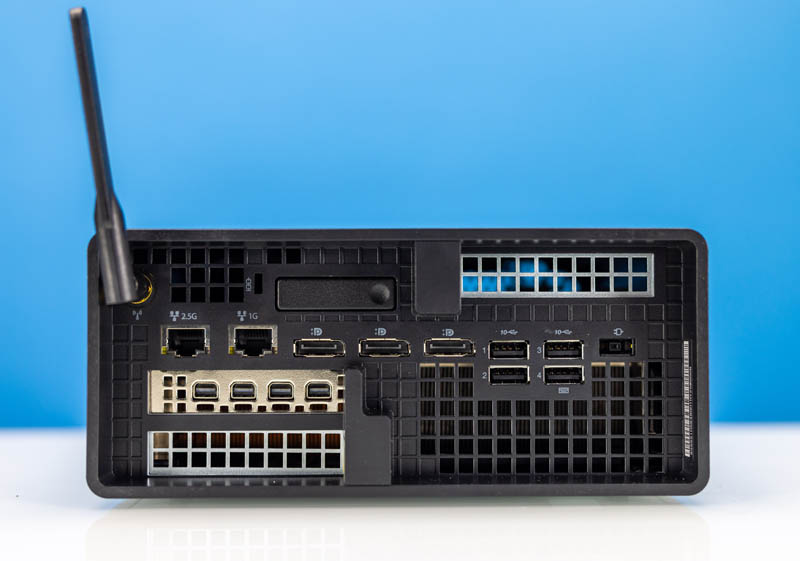
Display outputs are super interesting. There are three base full-size DisplayPort outputs. In our system, we have an additional four mini DP ports. One use case for this system is powering a lot of displays.
Also, on the rear, we have a lock port, a PSU input port in the shape of Lenovo’s notebook power adapters, and a WiFi antenna. There is also a low-profile PCIe slot that we are going to get to in our internal overview. To get inside the system there is a latch above two of the DisplayPorts. Let us get inside the system.

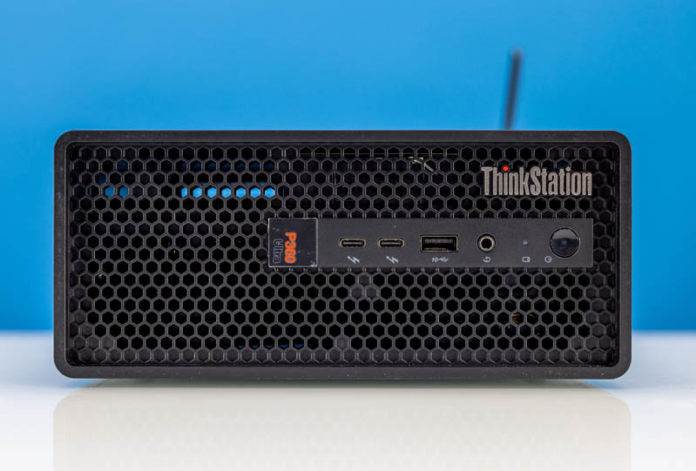



To be fair, for this price point I would have hoped to see an integrated 10G NIC. I know that one could just add it in the extra slot, but then that takes away the opportunity of using it for more specialized equipment, such as a professional sound or video capture card.
I think that is totally right Robert. 10Gbase-T (or even SFP+ with the option for a SFP+ to 10Gbase-T adapter) would have been really nice especially with the Mac Studio out there.
What’s funny is they are listing this as a RTX A5000 Mobile (https://www.techpowerup.com/gpu-specs/rtx-a5000-mobile.c3805).. which is spec for spec the exact same as a RTX A4000 (https://www.techpowerup.com/gpu-specs/rtx-a4000.c3756)
The real interesting part is if this is on a seperate PCB (which it looks like it is, would love a picture of just the card) this now sits at the highest power Low Profile GPU on the market. Basically giving you a 3080 in a Two-Slot LP form factor.
This GPU is kinda bonkers and would love to see more tests of it specifically as well as a breakdown of the PCB and how they are able to get the power consumption to work in this chassis.
Anyways I thoroughly love the SFF content on here and hope for more TMM related content in the future!
Sadly no 10Gbps NIC, sadly A5000, not 3080 or 3090
I thought Lenovo stopped using those rectangle power connectors. Stupid non-standard connector.
I would have liked to see the Geekbench 6 results for the Mac Studio with the M1 Max and M1 Ultra thrown into your mix of results as well.
I looked them up myself, and the M1 Max results weren’t too far off what you got here. Of course the OpenCL results were higher for the NVidia card, but you could spec an M1 Max Studio for $2799 ($1500 less than you listed for this) with 64GB RAM and a 4TB NVMe.
Of course, the Studio isn’t upgradeable, but for that price difference you could just buy an M2 Mini if you need more ports! :)
Oops, Sorry. I meant to type $3,799 ($500 less). My bad.
I don’t understand the form factor. It’s small enough to put on a desk next to the monitor but the fans are too loud. Is this intended for gaming where the user wears a sound-isolating headset? Do video content creators usually wear headsets while they are working?
This is a nice step up from the Dell Precision 3260 Compact
I just purchased one… I need to create a solution for a future MacBook Air loving Aerospace Engineering major that will need the ability to run SolidWorks and other x86/AMD64 software that does not run on a M1/M2. Plus I LOVE SMALL POWERFUL COMPUTERS…
It utilises a W680 motherboard so does ECC sodimm ram usable here ?
Yes you can get custom configurations with ECC memory. None of the standard configurations have ECC. I have 2 32GB ECC SODIMMs. On the A2000 at least (the config I own) you can also enable ECC on the GPU. The things I would prefer would be a SDCard slot on the front (to download from cameras), and the ability to adjust the P1 power throttle. The default is up to 56 seconds thermal throttled (Tau), and then the P1 limit takes it down to 75W, performance and fan noise go down. The fan is lot noisier when thermal throttled, but if I were doing a 15 minute render, I might prefer noisy and 20%+/- more performance. A 5 year on site repair warranty was only $111 so perhaps Lenovo feels running above the rated CPU TDP degrades long term reliability.
Just got one of these P360 Ultras and put esxi 8.0 on it. Seemed great until I spun up an Ubuntu VM to be a dhcp server. Looks like the on board NIC (port 0) blocks/intercepts outgoing UDP port 68 packets (aka DHCPOFFER). I tried disabling MEBx/vpro, but didn’t seem to matter.